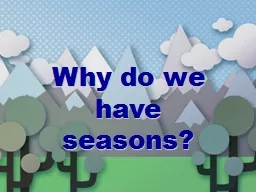

Earths rotation The Earth rotates on its axis imaginary vertical line around which Earth spins every 23 hours amp 56 minutes One day on Earth is one rotation of the Earth Day on Earth is when our side of the Earth faces the sun ID: 504962
Download Presentation The PPT/PDF document "Why do we have seasons?" is the property of its rightful owner. Permission is granted to download and print the materials on this web site for personal, non-commercial use only, and to display it on your personal computer provided you do not modify the materials and that you retain all copyright notices contained in the materials. By downloading content from our website, you accept the terms of this agreement.
Slide1
Why do we have seasons?
Slide2
Earth’s rotation
The Earth rotates on its axis (imaginary vertical line around which Earth spins) every 23 hours & 56 minutes. One day on Earth is one rotation of the Earth.
Day on Earth is when our side of the Earth faces the sun.
Night on Earth is when the side of Earth we are on faces away from the sun.Slide3
Earth’s revolution
It takes the Earth 365 days (or rotations) to travel or revolve around the Earth once. This is called a year.Slide4
Why do we have seasons?
The Earth’s orbit around the sun is NOT a perfect circle. It is an ellipse.Seasons are not caused by how close the Earth is to the sun. In fact, the Earth is closest to the sun around January 3 and farthest away from the sun around July 4.
Ellipse Slide5
Why do we have seasons?
Seasons are the result of the tilt of the Earth's axis. Earth’s axis is tilted 23.5°.
This tilting is why we have SEASONS like fall, winter, spring, summer.
The number of daylight hours is greater for the hemisphere, or half of Earth, that is tilted toward the Sun.Slide6
Why do we have seasons?
Summer is warmer than winter (in each hemisphere) because the Sun's rays hit the Earth at a more direct angle during summer than during winter Slide7
Why do we have seasons?
Also the days are much longer than the nights during the summer. During the winter, the Sun's rays hit the Earth at an extreme angle, and the days are very short. These effects are due to the tilt of the Earth's axis.Slide8
Seasons…in a nut shellSlide9
Solstices
Solstices occur twice a year, when the tilt of the Earth's axis is oriented directly towards or away from the Sun, causing the Sun to appear to reach its northernmost and southernmost extremes.
Winter solstice is the shortest day of the year. In the Northern Hemisphere. It occurs on December 21 and marks the beginning of winter.
The Summer Solstice is the longest day of the year. It occurs on June 21 and marks the beginning of summer.
Tyrrhenian Sea and Solstice Sky
Credit &
Copyright
:
Danilo Pivato
Slide10
SOLSTICE
During the winter the Northern Hemisphere day lasts fewer than 12 hours and the Southern Hemisphere day lasts more than 12 hours.
During the winter solstice, the North Pole has a 24-hour night and the South Pole has a 24-hour day.
Sunlight strikes the earth most directly at the Tropic of Capricorn.
http://k12.ocs.ou.edu/teachers/reference/solstice.gif
Slide11Slide12
Equinoxes
A day lasts 12 hours and a night lasts 12 hours at all latitudes.Equinox literally means "equal night".Sunlight strikes the earth most directly at the equator.
This occurs twice a year.
http://k12.ocs.ou.edu/teachers/reference/equinox.gif
Slide13
Equinox
The vernal (spring) equinox occurs March 21.The autumnal (fall) equinox occurs September 21.Slide14
The Earth's seasons are not caused by the differences in the distance from the Sun throughout the year.Slide15
The seasons are the result of the tilt of the Earth's axis.
I know this is a repeat, but it is important that you understand this idea. Many Americans, including Harvard graduates, do not know what causes seasons!Slide16
ReviewLook closely at where the Sun is hitting the Earth during each season:
http://Search.Lycos.com/setup.asp?r=5&src=clear2&query=weather+savvy
Slide17
http://www.nmm.ac.uk/uploads/gif/seasons-full.gif
Slide18
Daylight Hours Across the Globe
Time is indicated as number of hours (h)
Jan Feb Mar Apr May Jun Jul Aug Sep Oct Nov Dec
10.5 h 11 h 12 h 12.5 h 13 h 14 h 14.5 h 14 h 12.5 h 12.5 h 11 h 11.5 h
14.5 h 13.5 h 13.5 h 12.5 h 11 h 11 h 11 h 11.5 h 11.5 h 12.5 h 14 h 14.5 h
12 h 12 h 12 h 12 h 12 h 12 h 12 h 12 h 12 h 12 h 12 h 12 h
17.5 h 15.5 h 13.5 h 11.5 h 10 h 8.5 h 8.5 h 9.5 h 11.5 h 13 h 15 h 16.5 h
5 h 7 h 10 h 13.5 h 17.5 h 21.5 h 22 h 18 h 15.5 h 11.5 h 8.5 h 5.5 h
12 h 12 h 12 h 12 h 13 h 13 h 12 h 12 h 12 h 12 h 12 h 12 h
15 h 14 h 13.5 h 12.5 h 11.5 h 10 h 10.5 h 11 h 11.5 h 12.5 h 14 h 14 h
9 h 10 h 11 h 13.5 h 15 h 17 h 16.5 h 15.5 h 13.5 h 11.5 h 10.5 h 9.5 h
24 h 24 h 19 h 14.5 h 0 h 0 h 0 h 0 h 7 h 15 h 24 h 24
h
*Miami, Brisbane,
Nariobi
, Punta Arenas, Nome, Singapore, Cape Town, Seattle,
Vostok